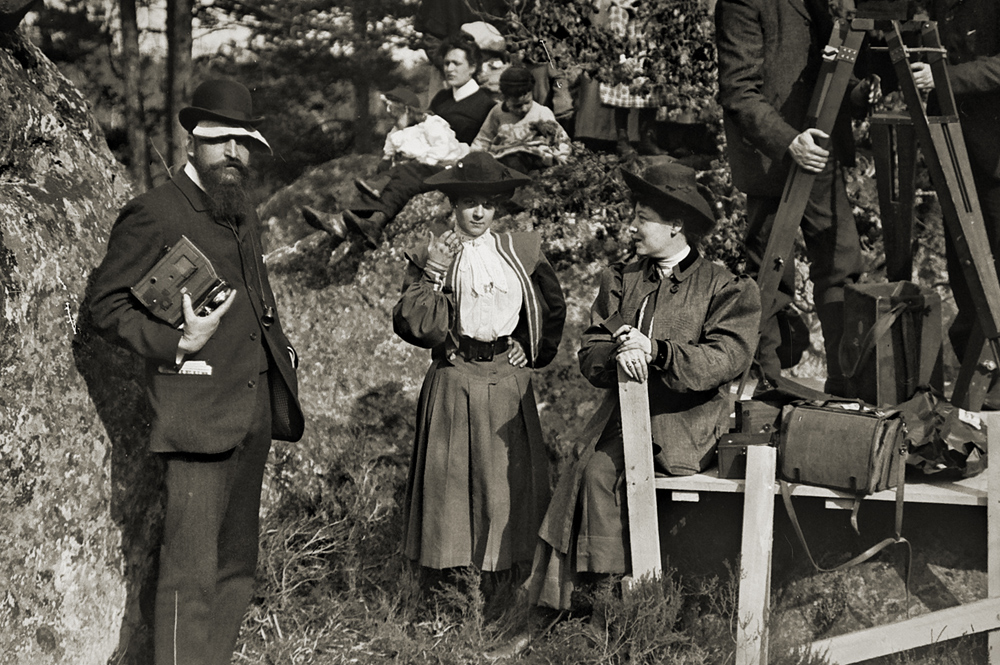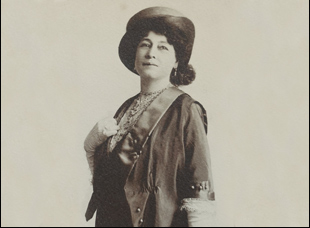There was precious little footage of the filmmaker Alice Guy Blaché available to Pamela B. Green to allow the subject of her film “Be Natural,” to speak for herself, so a televised 1964 interview that Paul Seban had conducted for the French program “Hieroglyphes” was quite the find, though there was a problem.
“There were subtitles that were covering her mouth that were burnt into the film,” recalls Green, who spent much of the last decade working on the film when not working her day job as a celebrated title designer for films such as “Blindspotting” and TV shows including “Mozart in the Jungle.” “Once the movie got into Cannes, we had a donor, Jamie Wolf, and it cost thousands of dollars to have it removed frame by frame so we could see her without covering her mouth with a black box.”
While Green means this literally, the black box was just one of many obstacles she lifted to give the true filmmaking pioneer her due, making a strong case for the silent film director not only figuring out early cinematic grammar after being invited to some of the earliest experimental screenings put on by Auguste and Louis Lumière in France, but crossing the Atlantic and building the studio infrastructure with the Solax Company that ultimately became a model for Hollywood production. Guy Blaché pushed the film industry forward in a number of ways, whether it was learning to sync sound with picture, casting hundreds of extras to create one of the first cinematic epics with “The Life of Christ” or making one of the first films to feature an African-American cast with the 1912 silent comedy “A Fool and His Money,” but rarely receiving the recognition of her male peers, “Be Natural” makes it feel as if Green is constantly pushing into new territory herself in uncovering the filmmaker’s history, scattered all over the world between various relatives in places such as Millrift, Pennsylvania and Show Low, Arizona and museums and film archives that have bits and pieces of her work.
Green, entertainingly (and begrudgingly), is pulled into the story as she goes to crazier and crazier lengths to collect these artifacts and preserve them, baking tapes to enhance their quality, consulting facial recognition experts to verify footage, and following Guy Blaché’s family tree wherever it may lead, but she also puts “Be Natural” in the present tense in a different way, sitting down with a number of contemporary filmmakers in a manner not unlike Henry Louis Gates’ “Finding Your Roots,” where a cross-section ranging from Lake Bell, Ben Kingsley, Julie Taymor, Jon M. Chu and many more trace their own careers and technique with what Guy Blaché originated. Following a triumphant debut at the Cannes Film Festival last year, it arrives in American theaters this week and Green spoke about the labor of love, how she got so many Hollywood heavyweights to be interviewed about a subject they initially knew so little about, and how her film could lead to resurfacing many of Guy Blaché’s films.
I saw her story on a TV show about women pioneers in cinema and I just couldn’t believe she accomplished so much and I just felt that she was a little bit robbed, so I had to do something about it. I didn’t know anything going in. If I knew it, I probably would’ve turned the other way and run. But I got a full education — I have a full Ph. D [now] in archival research and dealing with all these different things. More than I need to know. [laughs] But you need to do that. In any job you need to do your work, and I knew that I wanted to find people that talked about her and I wanted to try to find descendants. And I wanted to try to find more films, but In my wildest dreams, I never thought I would come up with all this stuff. I overdid it. Anything I do, I overdo it.
You have that wonderful opening where you ask a number of film industry professionals whether they know who Alice Guy-Blaché is, only to get a mostly resounding “no.” Since you continue to talk to them, how did the interviews go after that?
I wanted to prove to the academics that we did not know about her and I wanted to take her out of the books and bring her to the masses, to a wider audience, so I knew by interviewing people in the industry who were her contemporaries, if she were around today, that’d be the right way to go. It’s like high school. If you listen to cool people, then people are like, “Oh yeah, okay.” She represents so many characters – she’s a writer/producer, head of her own studio. She acted in some of her films, so it was a lot. And everybody [we interviewed] was sent a lot of material. I actually had a binder [to give the interviewees] before I started the interviews, so they were reviewing the information and they were reacting according to what they saw and her films, so everything is very authentic. Peter Farrelly came with a list with all of her films and started talking about each one by one.
And if you notice, I have them ask questions because they don’t know her, and one of the things that frustrates me is you have somebody in a film sometimes, but [they] don’t know anything and it’s just because [they’re] famous [that they’re] put in there. So this was really thought out. [We talked to] Andy Samberg [because he] did the digital short form [videos], and that’s how Alice started and then she moved into features. Mark Romanek started with music videos and then he moved into features. So there’s a lot of curiosity about her that resonates with the audience, so when the audience hears those questions, they’re like, “Oh yeah, I’m wondering about that too.”
When you’re sifting through archives, was there anything that changed the direction of things?
When I found the Ampex [U-Matic] tapes, that was amazing. That really helped because it was a dream come true to [see Simone, Alice’s daughter] react to what’s happening. Then when I found those pictures from “The Life of Christ” two weeks before [our premiere in] Cannes, those pictures didn’t exist before in that section, so that added something. I just kept cutting out more of the detective [story] and added more about Alice and more of her daughter.
What was interesting to me is I loved all the technologies. [With Alice’s career] you start with a postcard and you go all the way to video, which is amazing to have, so [it was important] for us to experience all that technology. The movie goes from a postcard – it’s 16mm, 35mm, 16 8mm, iPhone, FaceTime, Skype — everything, so it’s kind of a celebration of technology at the same time [about] the birth of cinema evolving into all these mediums. And to bake a tape was ridiculous, so I had to show it in a way to an audience where you could laugh about it a little bit.
Did you end up connecting people through your own search that could lead to preserving this history?
Many people met other people through this and descendants found out about their ancestry. Doris Kenyon, the actress from “Ocean’s Waif” — her stuff was basically donated to the Academy because of me. I found too much stuff that doesn’t even have anything to do with me — or with Alice. [laughs] But I did this for her. I’m the last chapter she didn’t get to do for herself because she’s too old and the world wasn’t ready for what needed to be done for her, so I’m going to set up a foundation so people can pay for keep preserving the films and also trying to get an American DVD going so people can see her films.
“Be Natural: The Untold Story of Alice Guy Blaché” opens in Los Angeles on April 19th at the Monica Film Center and on April 26th in New York at the IFC Center. A full schedule of cities and dates is here.





